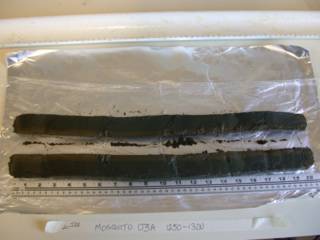One of the initial papers is Connerney et al. in Science, "Magnetic lineation in the ancient crust of Mars." Then there's a really detailed paper on the "Magnetic field of Mars: Summary of results form the aerobraking and mapping orbits" (Acuna et al. 2001). That one has some really nice graphics of the remanent magnetism of the crust.
Both papers state that:
The observations show that the majority of the crustal magnetic sources lie
south of the dichotomy boundary on the ancient, densely cratered terrain of the
highlands and extend ~60 degrees south of this boundary. It is inferred
that the formation of the dichotomy boundary must postdate the cessation of
dynamo action because of the clear magnetic differentiation between the terrains
on either side of the boundary. The absence of detectable crustal
magnetization north of the dichotomy boundary in spite of a widespread record of
active volcanism and magmatic flows suggests that dynamo action had ceased at
this stage of thermal evolution and crustal differentiation (Acuna et al. 2001).
So there's a difference between the northern and southern hemispheres of Mars, really apparent when you look at the pictures. I've also been looking at a couple of other papers, one about the "Influence of early plate tectonics on the thermal evolution and magnetic field of Mars" (Nimmo and Stevenson 2000). This paper is in the Journal of Geophysical Research v. 105. They assert that:
Recent magnetic studies of Mars suggest that (1) it possessed a periodically reversing magnetic field for the first ~ 500 Myr of its existence and (2)plate tectonics may have been operating during this time ... if plateAnyway, this is interesting because it talks about a link between plate tectonics and core convection. The paper presents good models for heat loss.
tectonics, or some other process causing high surface heat flux, was
occurring on early Mars, it is likely to have caused convection in the core
and hence generated a magnetic field. Conversely, a reduction in
surface heat flux would probably have caused the core to stop convecting an
shut off the magnetic field. There is thus an important link between
surface processes and core magnetism, which may also be relevant to planets
such as Earth and Venus.

